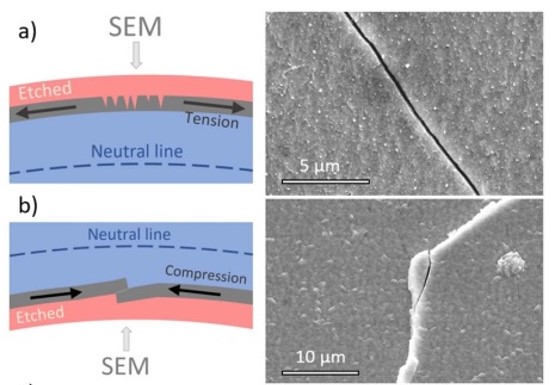Bending of coated superconductors

Composite conductors based on high-temperature REBCO (rare-earth cuprates) superconductors reach high transport current densities (1010 [A/m2]) at liquid nitrogen temperatures (‑193 ˚C), which makes them good candidates for high-field magnets (tens of Tesla). That makes them an interesting option for high-power cables, magnetic resonance, nuclear magnetic resonance, etc. In contrast to standard copper wires, which have circular cross-sections, and are easy to shape and bend, REBCO coated conductors are fabricated in the form of thin (1-3 µm) layers. For effective power transmission and to achieve high magnetic fields, it is necessary to form them into effective cables. A circular cross-section is one of the possible arrangements.
Layer structure of REBCO coated conductors has mechanical properties comparable to ceramic materials, which limits the bending of the conductor. At certain limits, the degradation of the superconducting layer occurs and can no longer transport current. The work examines the bending of coated conductor prepared with ISD (Inclined Substrate Deposition) technique dependent on conductor orientation, lay angle, and core diameter. We determine the critical current degradation dependent on these parameters. In conductor orientation with expansive orientation, we observe degradation of critical current already at 10 mm diameter. However, in case of compressive orientation of coated conductor, we observed that the lowest diameter for conductor bending is 3 mm at 30 deg. At higher diameters (4 mm, 5 mm) we observed mild critical current change up to 60 deg.

Authors: R. Ries, F. Gömöry, M. Mošať, T. Kujovič, C. Hintze and P. Gil
Supercond. Sci Technol. 36 (2023) 014006.
DOI: 10.1088/1361-6668/aca6ad
Compiled by M. Mošať
 Contact
Contact Intranet
Intranet SK
SK

